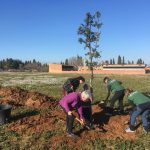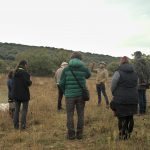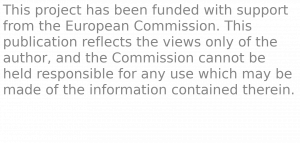The European project “Resilient Farmlands: Promoting education to boost ecosystem services of farmlands” has ended. Since September 2019, Resifarms promoted knowledge exchange between the participating organisations, directly trained farmers, agricultural technicians and biodiversity technicians, elaborated training materials, improved the conservation status of semi-natural habitats on farms and raised interest on the farming benefits of biodiversity among different local actors.
Farming benefits of nature conservation
Semi-natural habitats, in contrast with crops, add complexity and maturity to farmlands. These properties allow the establishment and persistence of hundreds of different species including trees, shrubs, herbs, mammals, insects, birds or fungi that interact with each other in a myriad of ways.
Properly managing these habitats, both biodiversity and farm resilience can be improved. Among other benefits, semi-natural habitats can provide resources for pollinators or pest controllers, protect from water pollution, wind, floods or droughts, and prevent soil erosion.
Information on these benefits begins to be known by farmers and agricultural technicians, but they often do not have the tools and enough applied knowledge to implement the necessary conservation actions.

A toolkit for the conservation of semi-natural habitats in agricultural lands
The main output of the project is the toolkit for the conservation of semi-natural habitats in agricultural lands, in which more than 50 organisations collaborated to varying degrees. This toolkit focuses on the farming benefits of nature conservation and gives advice on the implementation of the most direct and effective conservation actions, with information, tips and references on how to evaluate and properly manage or create semi-natural habitats.
The toolkit contains a couple of introductory chapters about the positive and negative effects of agriculture on the environment, and the farming benefits of biodiversity. Then it includes ten tools, the first two devoted to seek help for nature conservation actions and to communicate these efforts. The six following tools cover the benefits and management of several semi-natural habitats: field margins, hedgerows, ponds and ditches, woods and tree lines, open spaces, and stone walls, terraces and farm buildings. The next tool covers landscape importance and management, and the last one is a template for recording conservation actions.
Four videos were also produced to complement the toolkit on the management of semi-natural habitats and farmers’ motivations and actions to conserve nature. The toolkit and videos are freely available on the project website in seven languages.

Training for farmers in five countries
The toolkit was used as a basis for the direct training of farmers, agricultural technicians and conservation technicians. More than 150 people, mainly farmers and technicians, were trained in Spain, France, Romania, Italy and the Czech Republic. The training sessions usually consisted of a theoretical part, which dealt with several tools, and a practical part on the management of semi-natural habitats in the field.
In addition, these training events provided feedback to improve the toolkit in order to better meet the needs of farmers.

Dissemination activities
Five sessions were held, one per country, to disseminate the results of the project among local stakeholders. These sessions gathered a total of more than 150 attendees. In addition, more than 50 volunteers participated in conservation actions to improve semi-natural habitats on farmlands.

Project activities also included meetings in several countries, to foster collaboration and knowledge exchange between people linked to partner organisations, through discussion sessions and field visits to inspiring projects.
This project ended, but our work to promote synergies between agriculture and biodiversity will continue.







